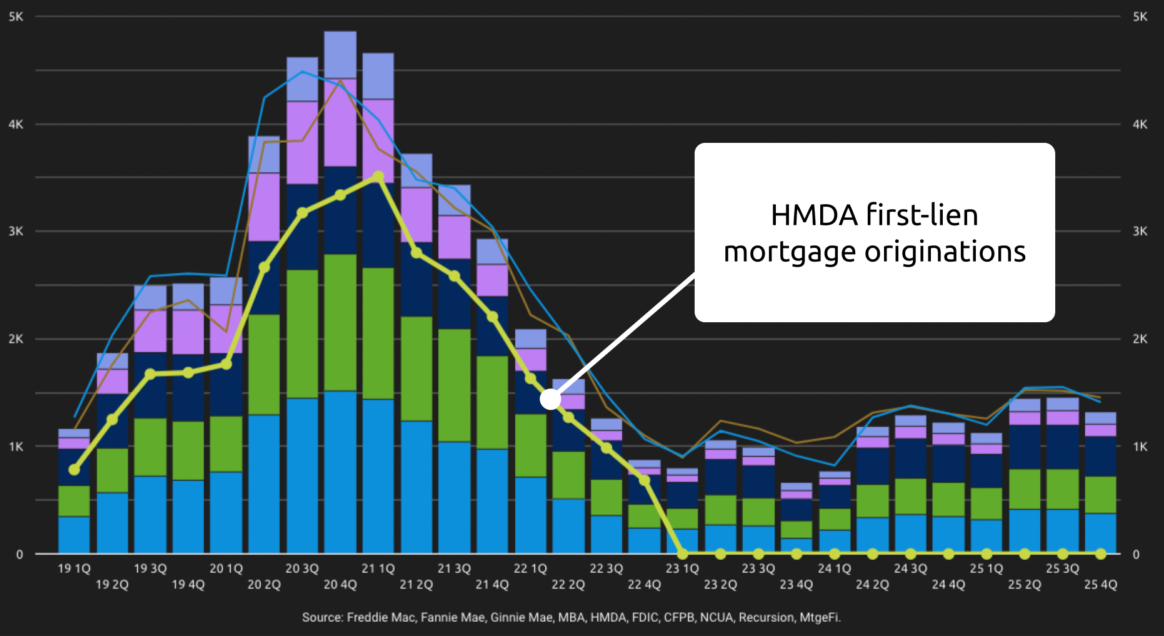Your cart is currently empty!
HMDA data is one of the go-to sources for residential mortgage originations in the US. This article looks deeper at the goals, guidelines and reporting requirements that lenders follow to produce HMDA data, and how you can best utilize the information.
MtgeFi has launched a mortgage originations model that addresses a couple of key challenges for mortgage technology companies and service providers:
- How do we create, maintain and reconcile a reliable business forecast (and budget) for single-family residential mortgage originations?
- How do we track our percentage share at a market, industry segment and individual lender level? Where should we focus our product and services to grow business?
In considering ways to address this challenge, a common questions is: ‘Why don’t we just use HMDA?’. This article addresses that question at a high level, and also provides references to HMDA dashboards and data sources for those where HMDA likely does provides sufficiently timely and detailed information.
There are several overlapping public and proprietary data sources in residential mortgage, but as Fannie Mae notes in the disclaimer of their monthly housing forecast “there is no universal source for market-wide originations data.”
HMDA Reporting Guidelines
The Home Mortgage Disclosure Act (HMDA) requires financial institutions to maintain and annually disclose data about home purchases, pre-approvals, improvements, and refinance applications involving mortgage loans.
HMDA was enacted in 1975 to primarily address fair lending practices and support policymaking, and includes reporting on the geographic distribution of loans and applications; ethnicity, race, sex, and income of applicants and borrowers; and information about loan approvals and denials.
Here is a summary of who is required to report under HMDA. Large lenders with over 60,000 reportable loans in the preceding year are required to report to HMDA quarterly, but these submissions are not disclosed as public datasets:

HMDA Data Coverage
In many ways, HMDA is the most definitive public data source for mortgage originations. It covers all financial institutions, specifying loan originators and aggregators, and records if loans were sold and the type of purchaser, including the agencies, private label MBS and other types of financial institutions.
There is reporting for first-liens, junior-liens, closed-end mortgages, and open-ended lines of credit for 1-4 family, multi-family and manufactured housing. Reverse, jumbo and conforming mortgage types are noted, along with the loan purpose covering purchase, regular refinance, cash-out refinance, home improvement, etc.
This table highlights the number and type of financial institutions covered in HMDA for 2022 compared to agency data, bank and credit union financial disclosures. This shows that HMDA has 86% coverage for agency issuers and only 54% coverage for depository institutions originating first-lien, closed-end, 1-4 single family mortgages.

There is also double-counting in HMDA where two different financial institutions report the origination and subsequent purchase of the same loan(s) during the calendar year.
HMDA Data Limitations
HMDA disclosures are focused on ensuring fair lending and supporting on-going policymaking. This data just happens to be very beneficial to businesses in the mortgage industry wishing to plan and budget for growth/decline at a overall market, industry segment and individual lender level.
The more obvious limitations are the delayed timing of the HMDA annual release, the lack of quarterly time-series data and the number of financial institutions that are not represented in the reporting. The HMDA Small Filer Exemption grants partial exemption from reporting all loan data points to smaller insured banks and credit unions. In 2022, this was over 1,200 financial institutions.
Some aspects of HMDA are voluntary, depending on whether a financial institution exceeds the reporting threshold for one or more the categories. Plus, the minimum loan volume thresholds have changed in recent years, impacting the reporting baseline.
One additional point about the timing of reporting is worth highlighting; the purchaser type is only recorded if a loan was either originated and sold, or purchased and then sold, within the same calendar. This tends to skew the reporting for the last couple of months of the year, and the year as a whole.
Conclusion
HMDA data provides a valuable source of data for mortgage technology companies, service providers and other market participants. But in building business forecasts & budgets HMDA may be better suited as a tool for reconciliation, validation and reference data, than a reliable source of single family residential mortgage originations.
The MtgeFi mortgage origination model utilizes monthly agency (FNM, FHL, FHA, VA, etc.) issuance and quarterly bank and credit union financial disclosures to provide accurate and timely information about recorded originations of single-family mortgages.
These ‘actuals’ can be compared with established industry housing finance forecasts that are updates quarterly, and finally reconciled with HMDA data when it is released the following year. MtgeFi utilizes unique identifiers for each financial institution eliminating the work identifying and reconciling individual lenders across these datasets every quarter, and enabling users to assess current revenues against overall lender volumes with their customer base.
For those where HMDA data is sufficient, here are links to access the Consumer Finance Protection Bureau (CFPB) mortgage data files and FFIEC quarterly charts.
